Orinoco
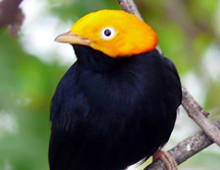
Golden-headed manakin, Pipra erythrocephala
This species is obviously closely related to the Red-capped manakin and shares part of its range in Panama, but is mostly found in Northern South America. The females of these two species are very similar, greenish with pale underparts. At present it is the most widely kept manakin in zoos and has bred in captivity, including the DWA.
LEARN MORE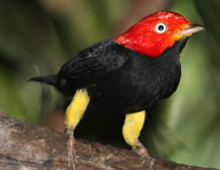
Red-capped Manakin, Pipra mentalis
The Red-capped manakin is well known to recipients of web-videos as the “Moon Walk” bird. That remarkable display of zipping back and forth by incredibly fast foot motion is its courtship behavior, which is taken to extremes by the various manakins. While most of the 146 species are South American, this manakin is found from Southeastern Mexico through Central America, to Ecuador.
LEARN MORE
Scarlet ibis, Eudocimus ruber
For decades this beautiful South American bird has been bred in American zoos and is now established as a self-sustaining population of more than 500. Birds bred in the US have been sent around the world. The brilliant color is dependent upon diet, so zoo birds are provided food rich in carotenoids. It is the national bird of Trinidad.
LEARN MORE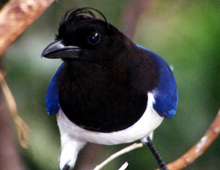
Curl-crested jay, Cyanocorax cristatellus
Found mostly in Brazil, as well as bordering parts of Bolivia and Paraguay, this uniquely colored jay could be seen in several American zoos in the 1970s, but has not been imported for many years. The DWA’s specimen, received through the cooperation of the Brazilian Government in 2000, is probably the only one outside of South America.
LEARN MORE
Crested oropendola, Psaracolius decumanus
Like the Green oropendola, this species comes from Northeastern South America. Its icy blue eyes contrast with its black feathers. The yellow tail feathers of oropendolas are prized by Native Americans for use in elaborate head dresses. Oropendolas prefer building their nests over water, and several can always be observed over the Orinoco crocodiles. Both Green and Crested oropendolas have bred at the DWA.
LEARN MORE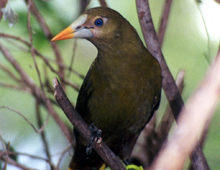
Green oropendola, Psaracolius viridis
These enormous grackle relatives are one of several species that build the hanging nests, looking like hairy bags, which can be seen in various places in the Orinoco rainforest. Males are much larger than females. The aquarium’s specimens are very fond of crickets and other insects and will come down to visitor level when their keeper provides them. They are skillful at picking them up with their beautiful two-colored beaks.
LEARN MORE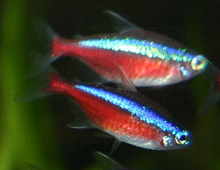
Cardinal tetra, Paracheirodon axelrodi
This popular aquarium fish was unknown to science until 1956, when ichthyologists at the Smithsonian Institution and Stanford University published descriptions a day apart. It took a meeting of the International Commission on Zoological Nomenclature to determine the Smithsonian had published first. Found only in the Rio Negro and Orinoco Rivers, they are provided both through ecologically sustainable collecting in Brazil and fish farms in Asia and Europe.
LEARN MORE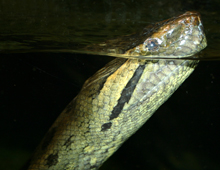
Green anaconda, Eunectes murinus
Exceeding 20 feet in length and 300 pounds in weight, this famous South American snake is by far the largest of the boas, and is the heaviest of the world’s snakes (the Reticulated python from Asia may grow slightly longer). Anacondas give birth to live young, usually 20 to 40 at a time. With their eyes near the top and end of their heads, they are adapted to an aquatic environment, and most of their prey is taken in or near water. At the DWA, they are fed rats. The largest specimen here is 14 feet long.
LEARN MORE
Plate-billed mountain toucan, Andigena laminrostris
Not seen in collections until the 1960s, this strangely beautiful bird from the cool Andean forests of Colombia and Ecuador was kept by a number of places in the 1970s and ’80s, and several were hatched. Today it is rare in captivity, but the DWA has recently been repeatedly propagating it. Because its mountain habitat continues to disappear, it is considered Near Threatened.
LEARN MORE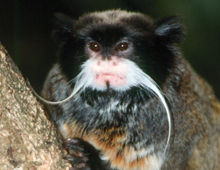
Emperor tamarin, Saguinus imperator imperator
Of the two subspecies of Emperor tamarins, this one, with a dark tail and no beard, is the less common in captivity. It is found in a small area of Brazil and Peru. Like other tamarins, the male takes care of the twins (the most common sort of birth), giving them to the female only to nurse. They usually stay with their family group (led by a dominant female) for around two years.
LEARN MORE

